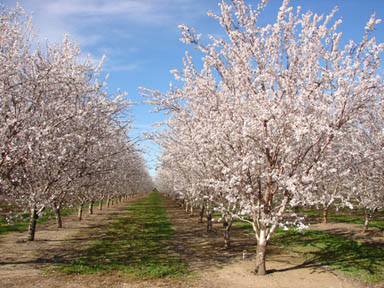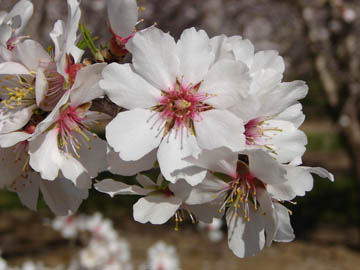Please note: This article is similarly named but different than the Almond Orchard (a shopping center in North Chico) .
California's great central valley is well known for its almond orchards. Durham can claim to be one of the leading cultivators of the hardwood trees and their nuts. Almonds were originally poisonous to mankind but humans were rather committed to propagating, and thereby domesticating, those rare mutations where the almond wasn't poisonous or bitter.
Other orchards planted in the area include walnuts.
If you're knowledgeable about almond orchards, please edit this page!
Planting
Commercial almonds are a grafted plant. Meaning the upper part of the tree is genetically different from the root system of the tree. The root system and the portion of the trunk belonging to it are referred to as root stock. Grafting is done to make the trees more hardy. Often there are rotting concerns or soil based pests that the root stock is resistant to that the producing part of the plant is not.
Planting occurs in early spring and late fall so that the new plants have time to take hold before the summer heat and dryness sets in.
Blossoming Period
Almonds bloom in mid-February through early march. They are pink to almost white in color. They smell faintly of honey. They are one of the first crops to bloom every year starting the commercial bee keeping season.
Harvest Time
Harvest time begins, depending on the cultivar, between the end of August and the end of September. At harvest time, the trees are shaken mechanically to encourage dropping of the almonds. This is where popular culture claims the 'l' out of almond is knocked out leaving "ah-mond" in common speech. Furthermore, shaking of the trees lofts a great deal of dust into the air which can make it a particularly irritating time for allergy sufferers and some vehicle owners. After the almonds are shaken off the trees, they are lined up in neat rows and vacuumed into almond haulers. These trucks go to a huller where the shells of the almonds are removed. Generally, these shells go on to feed cattle. Once that is done, they're shipped off wherever they're needed for further processing such as roasting.
Orchard Locations
 |
This entry is a seed, a starting point for writing a full entry. You can help LocalWiki Chico by expanding it! Just click the "Edit" button. |




